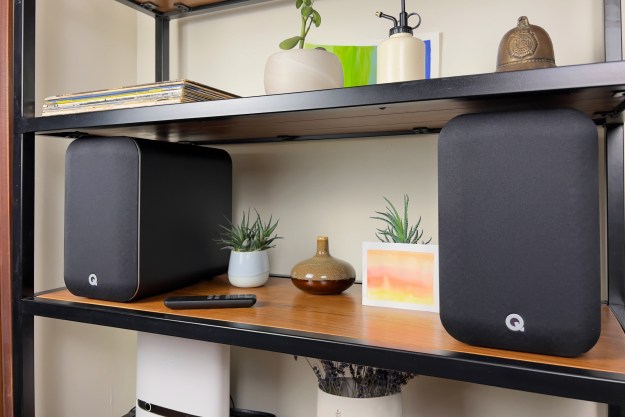
“The Q Acoustics M20 HD Powered Wireless Music System shouldn't be dismissed as just another set of desktop Bluetooth speakers.”
- Clear, refined sound with any music
- Wide soundstage in any room
- Versatility of placement
- Tons of connectivity options
- aptX HD Bluetooth
- A bit big for desktops
- Better with a subwoofer
“Hey, do you want to review a set of powered desktop Bluetooth speakers?” is what my colleague asked me. First, of course I do, because I like speakers and I like my job. But one of the most fun parts of reviewing products is when you dig into something new and find that it isn’t what you were expecting.
Sure, the Q Acoustics M20 HD are, at first glance, a pair of powered Bluetooth speakers that I’m sure would be quite content (can speakers be content?) relegated to any home office desktop. And they were, happily tucked in behind my computer monitor for weeks. I was happy, too. Domestic audio bliss. But then I noticed the “Powered Wireless Music System” moniker on the box. Duh.
After removing my palm from my face, I relocated the M20s to a bookshelf in my dining room. Then I tried them with my turntable. Then my TV. And my phone. They’re so moveable I even took them to my cottage. With a ton of connectivity options, from RCA to USB to 3.5.mm AUX to optical to Bluetooth, there wasn’t anything I couldn’t try the M20s with, save for Wi-Fi. You can even hook a subwoofer up to them (more on that later).
Should the Q Acoustics M20 HDs stick to the desktop Bluetooth speaker lane, or are they a muscle car longing for the open road? Should I stop with the car metaphors? And, more importantly, should you buy these speakers? Buckle up.
What’s in the box?
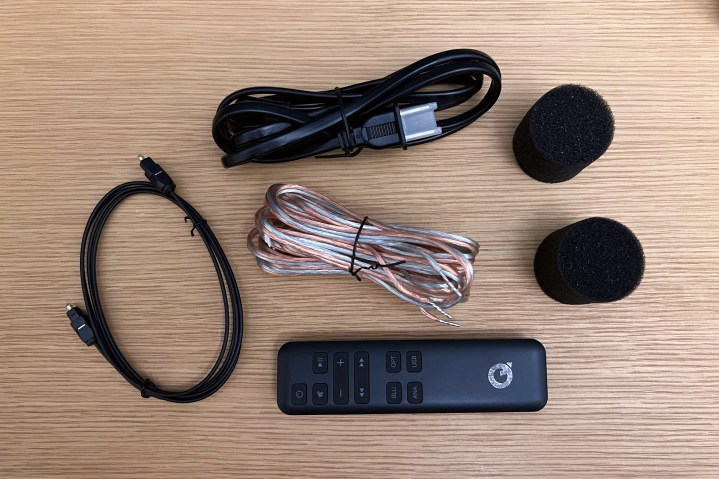
What’s in the box of the Q Acoustics M20 speakers is as straightforward as the speaker system itself. There’s one powered main speaker, and a companion passive speaker. A small box inside the packaging reveals everything else needed to get up and running quickly: a 4-meter (13-foot) speaker cable for linking the speakers, a 2-meter (6.5-foot) power cable, a remote control with batteries an optical cable, two foam bungs for the rear port, and a user manual.
Design and features
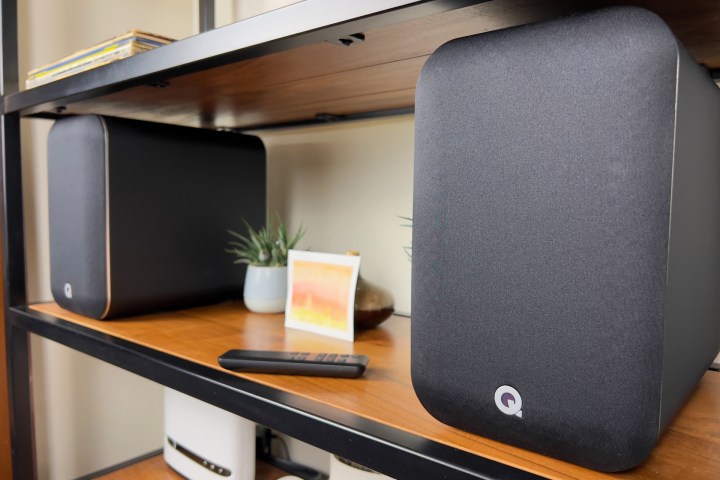
Build and drivers
To be clear, the Q Acoustics M20 speakers are not what I would call a small pair of desktop speakers like the more compact, budget set of Monoprice desktops we recently reviewed — these things are substantial, but still moveable. Each speaker weighs a little over 10 pounds (11.25 pounds for the passive speaker and 12.2 pounds for the powered), and they’re solid as a rock with a stylish matte black finish (they’re also available in white and walnut). The mesh grilles are also nice, and are sealed flush to the cabinets with a sleek band of aluminum. This also means that the grilles, unfortunately, do not come off, which might not be a problem unless you need to clean them.
Behind the grilles, each of the M20’s speakers houses a 22mm (0.87-inch) “high frequency” tweeter that is decoupled from the cabinet, which Q Acoustics says helps minimize any unwanted vibrations inside. The midbass driver is a 125mm (4.92-inch) cone that puts out an impressive amount of sound for its size — enough to fill any medium-sized room — and is driven by a built-in 130-watt amplifier. There’s also a rear-firing reflex port on the back to help with bass dispersion, which can be blocked with the included foam bungs to fine-tune the low end if the backs of your speakers need to be close to or flush against a wall. And you may need to do this because, as I mentioned, these speakers aren’t small, at 11 inches tall by 6.7 inches wide and a shelf-filling 11.6 inches deep.
There’s a plethora of connectivity options to this $600 music system.
The top of the powered speaker is where you’ll find a flush power button that cleverly illuminates a different color based on what connection is being used, and up/down volume buttons. You can use the power button to manually scroll through the inputs or you can use the included remote (a nice touch), which is a compact size with all the inputs clearly marked.
All the connections are well organized on the back of the powered speaker (we’ll get into those below), with the passive speaker clean and clear except for the speaker cable terminals.
Connections
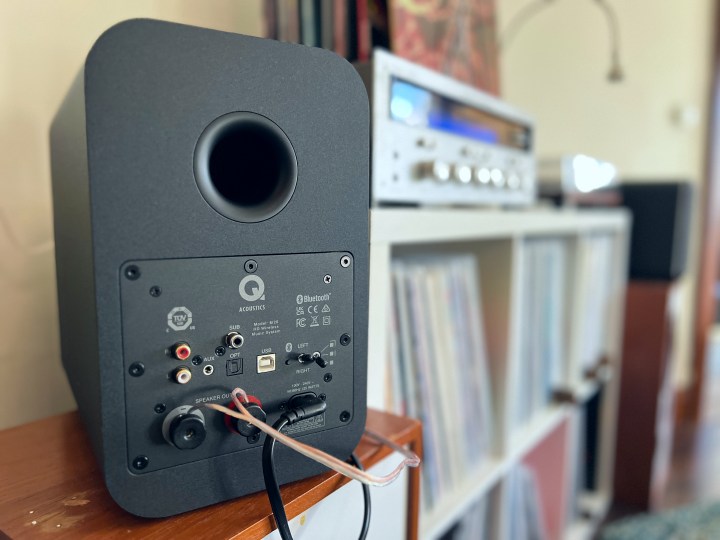
This is where the Q Acoustics M20s get fun. As mentioned in the intro, there’s a plethora of connectivity options to this $600 music system. It’s important to note that the M20s are not Wi-Fi-enabled and cannot stream anything over a network like a Sonos system (there is a way, though — read on).
Bluetooth is the wireless connectivity here, but it’s beyond many cheaper systems on the market in that it supports aptX, aptX Low Latency, SBC, and AAC wireless codecs. It also supports the aptX HD Bluetooth codec, which enables high-resolution wireless audio streaming up to 24-bit/48kHz. That right there is some pretty great sound capability, but if you’re even more of an audiophile, you can connect the M20s to a computer via the USB port or hook up the Toslink optical port to a compatible component to unlock lossless audio quality at 24-bit/192kHz — from high-res native files or through streaming services such as Tidal, Apple Music, and Amazon Music Unlimited. The optical ports can also be used to connect the M20s to a compatible TV to run sound through that way.
A set of RCA inputs opens things up even more, allowing connections to everything from CD and DVD players to turntables — and just about anything with the right cables and adapters. You can even use the RCA line-in to connect to Wi-Fi network streaming devices like the Bluesound Node or the Sonos Port — now you’ve got yourself a decent network streaming setup.
The M20s are superb-sounding speakers, offering amazing tonal balance, a wide soundstage, and impressive volume for their size.
There’s also a port for connecting an external subwoofer should you enjoy big bass, and even if a single 3.5mm cable is all you have, there’s one of those on the back, too — I like to have one connected in case friends want to hook up their phones to the speakers without fussing with Bluetooth.
Setup
No need to get too into the weeds here: setting up the M20s is easy and really configurable. Once you’ve chosen their location (shelf, desk, media unit), just plug in the power and link the two speakers together with the included speaker cable and the red/black speaker terminals on each speaker.
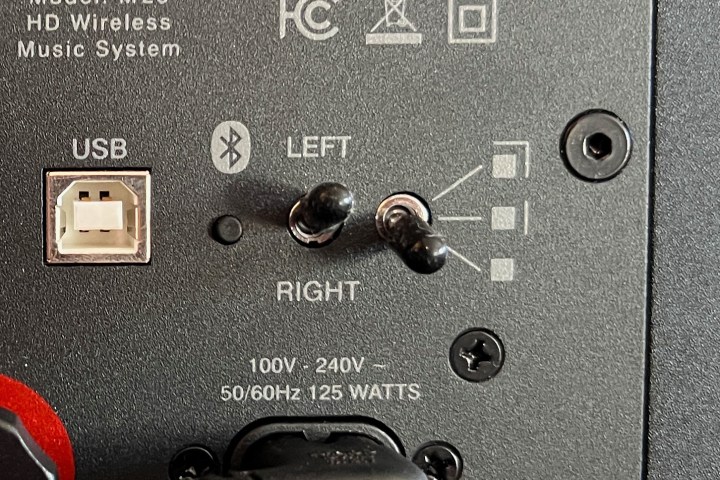
Q Acoustics then goes that little extra distance with a couple of handy toggle switches on the back of the powered speaker. One lets you choose the left/right orientation of the powered speaker (which is great if you need the main speaker in a certain position to access the power button or the inputs), and the other is a three-way selector that lets you fine-tune the EQ if the speakers are set up in a corner, against a wall, or in an open space. Q Acoustics says that the system uses digital processing to optimize the sound, which comes in handy if you plan on moving the speakers around, which you might very well do.
There’s a Bluetooth button on the back for easy initial pairing, or you can hold down main power button in Bluetooth mode to put the speakers in pairing mode. Otherwise, connecting your chosen wired connection is probably the toughest decision you’ll have (note that other than the optical cable, the M20s do not come with any other cables). Now all you have to do is use the remote or the top power button to choose your input.
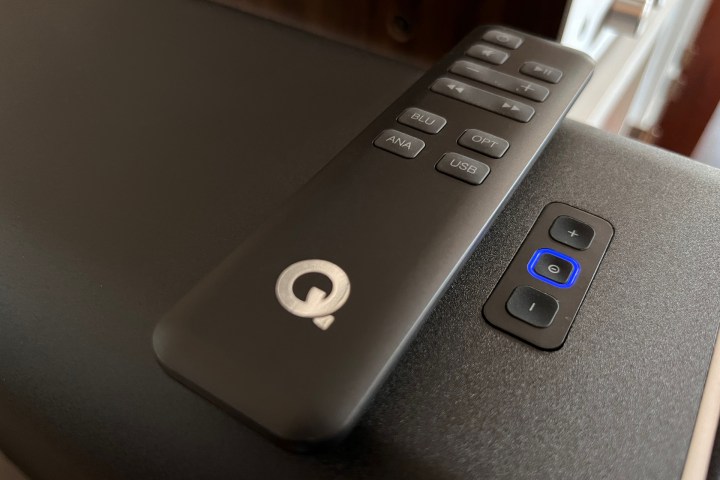
Sound quality and performance
What can I say, the M20s are superb-sounding speakers, offering amazing tonal balance, a wide soundstage, and impressive volume for their size. They sound crystal clear and tight, especially in the mid and high frequencies, and even at higher volumes, no matter the music style or source. I fed the M20s everything from The Beatles and Pantera to Michael Bublé Christmas tunes to Billy Eilish and the Jonas Brothers (I have a 12-year-old). I did this from hi-res lossless Apple Music, Tidal, and Amazon Music, as well as over Bluetooth, from my computer through the USB port, and even through a phono preamp so I could play some vinyl. Everything sounded great. Spotify Premium’s 320kbps was the only source that sounded slightly less defined compared to the others, but that’s on them.
The Q Acoustics M20s more than lives up to its name as a Powered Wireless Music System, and it’s easily one of the most versatile and best-sounding speakers systems I’ve ever heard.
Positioning flexibility is one of the M20’s best features, and they did indeed sound great no matter where I put them — behind my computer monitor, on a bookshelf in my dining room, with my turntable setup in my living room. The EQ switch came in really handy, and experimenting with the toggle based on where I put them returned subtle nuances in the sound, but I could definitely tell the difference. This helped me pull the best sound from the M20s, except … .
The one area I felt was a little lacking was in the low end, where even Eilish’s bass-drenched track Xanny could use some help. I must confess, though, I do prefer more bass than most. I will say that the EQ switch did help here, balancing the low end depending on where in the room I was standing. Using the foam bungs inserted in my desktop computer setup also yielded good results there. The best sound I managed to get was with the speakers around 5 inches from the wall, in a corner, with the speakers slightly angled inward and with the foam inserts removed. But if the M20s are going to be your main system, either for music, gaming, or home theater, I’d recommend adding a subwoofer, even a small one. When I did that for this review, the low end was on a whole other level, well-balanced and full.
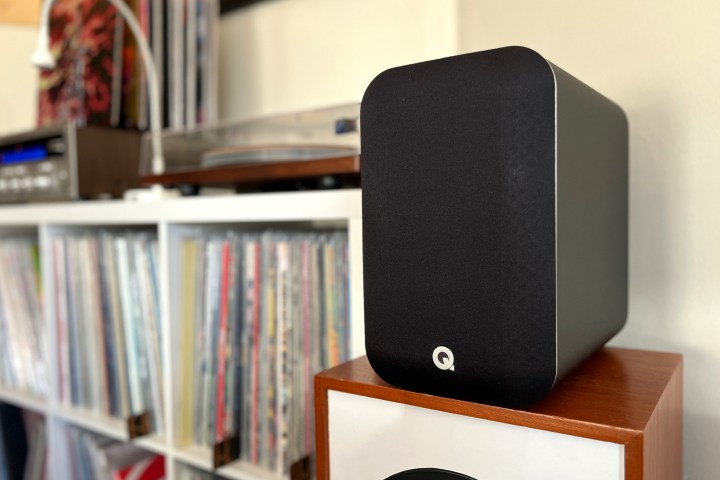
The bottom line
The Q Acoustics M20s more than lives up to its name as a Powered Wireless Music System, and it’s easily one of the most versatile and best-sounding speakers systems I’ve ever heard. They are beyond simply being a set of desktop Bluetooth speakers, so if that’s all you’re after, then look elsewhere, as you’ll be holding these things back from their full potential. And for a more-than reasonable $599, they’re worth every penny. Q Acoustics also told me at the time of this writing that there’s a promo price of $499 on the M20s, so there’s that as well.
Unfussy in their setup and placement, I struggled to find anywhere in my home where they didn’t sound great, even if they took a little coaxing, which Q Acoustics cleverly took into consideration by making them so easy to configure. Connectivity options abound with the M20s, which give them longevity no matter what new devices come along. As far as competitors to the M20s, you could have a look at desktop speakers like the Kanto YU6 or save a little money with the Audioengine A2+, but neither can compete with the M20s.
Should you buy them? A wholehearted yes.
Editors' Recommendations
- Best Bluetooth speaker deals: Save on Bose, Sonos, JBL, and more
- The best Bluetooth speakers for 2024: Marshall, Soundcore, JBL, and more
- The best Bluetooth speakers for under $100
- Edifier MP230 Hands-on Review: The pint-sized, retro Bluetooth speaker brings a vintage vibe
- This Bose Bluetooth speaker is just $79 for Prime Day — save $50





